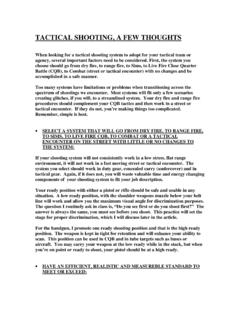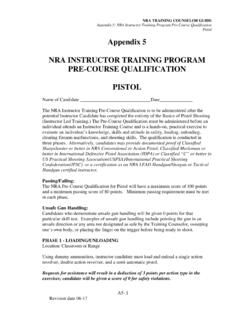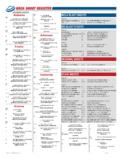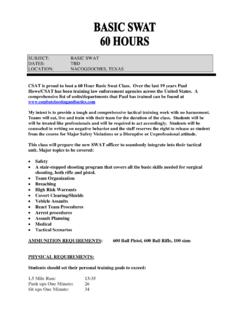Transcription of Advanced Tactical Handgun Instructor Manual 2010
1 ACTION TARGET ACADEMY 1 Advanced Tactical Handgun Instructor ACTION TARGET ACADEMY 2 TABLE OF CONTENTS PROGRAM GOALS .. 3 AND 3 COURSE 5 FIREARMS SAFETY RULES .. 7 Instructor 8 COACHING SKILL 26 TRAINING CONSIDERATIONS .. 32 COURSE DEVELOPMENT .. 40 PHYSICAL CONDITIONING FOR LAW ENFORCEMENT 42 RANGE COMMANDS .. 47 TEACHING BASIC SHOOTING 53 WHY SHOOTERS FAIL .. 59 SHOOTING DRILLS .. 62 AMMUNITION .. 63 GETTING THE RIGHT TWIST .. 89 COVERT CARRY AND PLAIN CLOTHES 91 Tactical 107 TRAINING CONSIDERATIONS .. 109 RANGE 116 REDUCED LIGHT TECHNIQUES .. 119 INTERACTIVE USE OF FORCE 138 COVERT CARRY Instructor PRACTICAL EXAM .. 145 FIREARMS PREVENTATIVE MAINTENANCE GUIDE .. 149 ACTION TARGET ACADEMY 3 PROGRAM GOALS AND OBJECTIVES Program Goal To elevate the Firearms Instructor and Range Master above the level previously certified by expanding their knowledge base, operational skills and instructional capability in the areas of officer survival, concealed / covert carry, and range operations.
2 This program will provide both technical and Tactical training techniques that are based on duty specific requirements. Therefore, the overall program goal is to develop an Instructor who is capable of teaching both the science of effective Handgun shooting at close quarters and the art of concealed carry to their personnel. This will be accomplished with a combination of both classroom and range activity. Program Objectives Upon successful completion of this program, the participant will know: 1. The influences that civil litigation, case law, and agency policy have on training and the application of force. 2. Instructional methods specific to long term retention of material. 3. How to conduct safe, effective training. 4. Adult learning theory as it applies to public speaking, classroom presentation, and motor skill development. 5. How to develop course of fire, tactics and techniques specific to concealed carry situations.
3 6. Coaching principles and effective on line instruction techniques. 7. Why shooters fail and what to do about it. 8. Understanding standard operating procedures (SOPs) for live fire range training. 9. Understanding advantages and disadvantages of concealed carry options. 10. Backup options. 11. Advancing the fundamentals of marksmanship for concealed carry. 12. Firearms safety in the office, home, and vehicle. 13. Concealed carry handguns - advantages and disadvantages. 14. Holsters and carry systems - advantages and disadvantages. 15. Equipment selection considerations. 16. Optional carry positions. 17. Optional equipment (flashlights, impact weapons). 18. Safe loading and unloading for concealed carry. 19. One-handed and two-handed drawing and re-holstering techniques. ACTION TARGET ACADEMY 4 20. CQB techniques for violent encounters. 21. Sighted and unsighted shooting techniques.
4 22. Dominant and support hand shooting techniques. 23. Justification of multiple shot techniques. 24. Identification and engagement of multiple opponents. 25. Shooting while moving. 26. Engaging moving threats. 27. Identification and utilization of cover. 28. Tactics and techniques in and around vehicles. 29. Diminished light techniques. 30. Inspection and maintenance. 31. Interactive force-on-force training. The student will be evaluated by the following methods: 1. Oral presentation. 2. Lesson plan development. 3. Practical examination. 4. Live fire courses. 5. Interactive force-on-force. 6. Overall safe weapons handling. ACTION TARGET ACADEMY 5 COURSE OUTLINE DAY 1: 1. Program introduction a. Program goals and objectives b. Staff and student introductions c. Safety rules, liability waiver d. How students will be evaluated e. Manual overview f. Firearms safety office, home, vehicle 2.
5 Instructor development a. Principles of adult learning b. Outline and use c. Lesson plan development d. Communication skills e. Public speaking f. Course development DAY 1: 1. Instructor development (continued) g. Coaching skill development h. Range commands i. Objective of on-line instruction j. Working with problem shooters k. Function check of handguns l. Live fire exercises i. One hole drill / sighted versus unsighted shooting m. Review of practical exam DAY 2: 2. Review of coaching techniques a. Support equipment 3. Understanding standard operating procedures 4. CQB techniques for violent encounters DAY 2: 5. Range operations and setup 6. Review of practical examination DAY 3: 7. Advanced tactics and techniques a. Movement b. Seated 8. Utilization of cover 9. Multiple threats / targets ACTION TARGET ACADEMY 6 DAY 3: 10.
6 Introduction to diminished light techniques and tactics (classroom) 11. Range: a. Flashlight techniques b. Tactical light techniques 12. Review of Practical Examination DAY 4: 13. Range: a. Shooting in, around, and from vehicles b. Vehicles, cover? and concealment DAY 4: 14. ASIS 3000 judgment shooting / prep for classroom presentations DAY 5: 15. Classroom presentations and feedback DAY 5: 16. Practical Exam coach / student 17. Final qualification course 18. Closing, critiques and graduation ACTION TARGET ACADEMY 7 FIREARMS SAFETY RULES A. CARDINAL RULES OF FIREARMS SAFETY: 1. Treat all firearms as though they are loaded. 2. Point the muzzle in a safe direction at all times. 3. Keep your finger outside the trigger guard until you are on target and have decided to fire. 4. Be sure of your target and what is beyond it. B. SPECIFIC RULES: 1.
7 Do you have any physical disability, limitation, illness or other condition that would affect your ability to participate safely in any aspect of this program? Yes _____ No _____ (Initials) 2. Are you under the influence of any prescription/non prescription drug or alcohol that would influence your safe participation in any aspect of this program? Yes ____ No _____ (Initials) 3. Ear protection, wrap around eye protection and hat with brim are required to be worn at all times while shooting on the range. This applies to shooters, instructors and observers. 4. When you pick up a firearm, keep your finger off of the trigger, point the muzzle in a safe direction, open the action and check both visually and physically to see that it is unloaded. 5. Check a second time. 6. Never give or take a firearm from anyone unless the action is open for inspection. 7. Load/reload/unload only after position is taken at the firing point and on command.
8 8. Keep the firearm pointed down range at all times. 9. Never draw a Handgun from the holster on the range unless instructed. 10. Never draw/re-holster with your finger in the trigger guard or on the trigger. 11. NEVER holster a cocked weapon (cocked and locked weapons excluded). _____(Initials) 12. Always wash hands and face after leaving the range and shower & change clothing at the end of a shooting day to reduce the possibility of lead contamination. 13. Never go forward of the firing line unless instructed. 14. Never step back from the firing line unless your Handgun is safely holstered, and the Instructor directs you to do so. 15. While on the firing line, never bend over to retrieve dropped articles until instructed to do so. 16. No talking on the firing line except by, or with an Instructor . 17. No eating, chewing tobacco or smoking on the firing line. 18. Pay strict attention to the Instructor and the tower.
9 19. Never anticipate a command. 20. Never permit the muzzle of a firearm to touch the ground. 21. Conduct a proper safety check of the weapon before and after a training session. 22. Never dry fire on the range unless instructed to do so. 23. All safety precautions must be adhered to and will be enforced.. 24. You are expected to use good judgment, and to refrain from attempting any exercise, which you may not be able to perform safely, based upon your own ability, equipment, prior training or physical condition. _____(Initials) 25. Eye protection MUST be worn when cleaning any firearm. _____ (Initials) 26. Females who are pregnant or breast feeding should not participate in firearms training or be allowed on the range. 27. REMEMBER: Everyone has the responsibility for range safety. ACTION TARGET ACADEMY 8 Instructor DEVELOPMENT ACTION TARGET ACADEMY 9 ACTION TARGET ACADEMY 10 ACTION TARGET ACADEMY 11 ACTION TARGET ACADEMY 12 ACTION TARGET ACADEMY 13 ACTION TARGET ACADEMY 14 ACTION TARGET ACADEMY 15 ACTION TARGET ACADEMY 16 ACTION TARGET ACADEMY 17 ACTION TARGET ACADEMY 18 ACTION TARGET ACADEMY 19 ACTION TARGET ACADEMY 20 ACTION TARGET ACADEMY 21 ACTION TARGET ACADEMY 22 ACTION TARGET ACADEMY 23 ACTION TARGET ACADEMY 24 ACTION TARGET ACADEMY 25 ACTION TARGET ACADEMY 26 COACHING
10 SKILL DEVELOPMENT I. OBJECTIVES OF ON-LINE INSTRUCTION The prime objectives for an Instructor while coaching the line are two-fold. First, the Instructor must be the comparative model for all skills and techniques to be developed in order to provide the student with a suitable visual learning experience. It is necessary that the Instructor demonstrate the skill at no more than one-half speed or power to reduce the incidence of student error associated with moving too fast. Additionally, the Instructor must be able to separate each skill into three component parts - beginning, middle and end - to demonstrate each motor skills stage and reinforce expected student behavior. Secondly, the Instructor must provide immediate individual feedback on performance to those being coached. A critique or evaluation that is delayed has limited training value. Further, constant criticism or attempting to indicate to the student everything that was in error all at once is counterproductive to student success.







